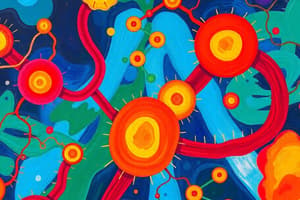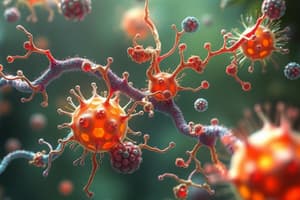Podcast
Questions and Answers
Which process involves the breakdown of complex molecules and releases energy?
Which process involves the breakdown of complex molecules and releases energy?
- Anabolism
- Photosynthesis
- Catabolism (correct)
- Metabolism
What is the term for the energy required to initiate a chemical reaction?
What is the term for the energy required to initiate a chemical reaction?
- Activation energy (correct)
- Metabolic energy
- Kinetic energy
- Potential energy
What is the name of the molecule that serves as the primary energy currency in cells?
What is the name of the molecule that serves as the primary energy currency in cells?
- ATP (correct)
- Glucose
- RNA
- DNA
What is the role of enzymes in metabolic reactions?
What is the role of enzymes in metabolic reactions?
Which of the following is NOT a factor that can affect reaction rate?
Which of the following is NOT a factor that can affect reaction rate?
Which statement accurately describes the relationship between anabolism and catabolism?
Which statement accurately describes the relationship between anabolism and catabolism?
What is the main role of metabolism in living organisms?
What is the main role of metabolism in living organisms?
Which of the following is an example of a metabolic pathway?
Which of the following is an example of a metabolic pathway?
Which of the following is NOT a characteristic of enzymes?
Which of the following is NOT a characteristic of enzymes?
Which of the following is a characteristic of a catabolic reaction?
Which of the following is a characteristic of a catabolic reaction?
What happens to an enzyme's activity when the temperature increases beyond its optimal range?
What happens to an enzyme's activity when the temperature increases beyond its optimal range?
At what pH is the enzyme illustrated in Figure 5.5b most active?
At what pH is the enzyme illustrated in Figure 5.5b most active?
What is the effect of increasing substrate concentration on the rate of an enzymatic reaction?
What is the effect of increasing substrate concentration on the rate of an enzymatic reaction?
What type of inhibitor binds to the active site of an enzyme and competes with the substrate?
What type of inhibitor binds to the active site of an enzyme and competes with the substrate?
What is an allosteric site?
What is an allosteric site?
What type of inhibition is characterized by the end-product of a reaction inhibiting an enzyme earlier in the pathway?
What type of inhibition is characterized by the end-product of a reaction inhibiting an enzyme earlier in the pathway?
What is the function of a ribozyme?
What is the function of a ribozyme?
Which of the following is NOT a factor that influences enzymatic activity?
Which of the following is NOT a factor that influences enzymatic activity?
What is the difference between a competitive inhibitor and a noncompetitive inhibitor?
What is the difference between a competitive inhibitor and a noncompetitive inhibitor?
Which of the following is an example of a ribozyme?
Which of the following is an example of a ribozyme?
What role do enzymes play in chemical reactions?
What role do enzymes play in chemical reactions?
What forms when a substrate contacts the enzyme’s active site?
What forms when a substrate contacts the enzyme’s active site?
What indicates the specificity of an enzyme?
What indicates the specificity of an enzyme?
How is the turnover number defined?
How is the turnover number defined?
Which of the following enzyme names indicates its function in transfer reactions?
Which of the following enzyme names indicates its function in transfer reactions?
What happens to proteins at high temperature or extreme pH levels?
What happens to proteins at high temperature or extreme pH levels?
What is the effect of high substrate concentration on enzyme activity?
What is the effect of high substrate concentration on enzyme activity?
What enzyme category is responsible for hydrolysis reactions?
What enzyme category is responsible for hydrolysis reactions?
What is a holoenzyme?
What is a holoenzyme?
Which enzyme class is responsible for joining molecules and utilizing ATP?
Which enzyme class is responsible for joining molecules and utilizing ATP?
Flashcards
Metabolism
Metabolism
The buildup and breakdown of nutrients within a cell, providing energy and sustaining life.
Catabolism
Catabolism
The process that breaks down complex molecules, providing energy and building blocks for anabolism; it is exergonic.
Anabolism
Anabolism
The process that uses energy and building blocks to build complex molecules; it is endergonic.
Metabolic pathways
Metabolic pathways
Signup and view all the flashcards
Collision theory
Collision theory
Signup and view all the flashcards
Activation energy
Activation energy
Signup and view all the flashcards
Reaction rate
Reaction rate
Signup and view all the flashcards
Exergonic reactions
Exergonic reactions
Signup and view all the flashcards
Endergonic reactions
Endergonic reactions
Signup and view all the flashcards
Enzymes
Enzymes
Signup and view all the flashcards
Catalysts
Catalysts
Signup and view all the flashcards
Active Site
Active Site
Signup and view all the flashcards
Enzyme-Substrate Complex
Enzyme-Substrate Complex
Signup and view all the flashcards
Specificity
Specificity
Signup and view all the flashcards
Turnover Number
Turnover Number
Signup and view all the flashcards
Enzyme Naming
Enzyme Naming
Signup and view all the flashcards
Factors Influencing Enzyme Activity
Factors Influencing Enzyme Activity
Signup and view all the flashcards
Denaturation
Denaturation
Signup and view all the flashcards
Saturation
Saturation
Signup and view all the flashcards
Enzymatic Activity
Enzymatic Activity
Signup and view all the flashcards
Optimal pH
Optimal pH
Signup and view all the flashcards
Substrate Concentration
Substrate Concentration
Signup and view all the flashcards
Competitive Inhibitors
Competitive Inhibitors
Signup and view all the flashcards
Noncompetitive Inhibitors
Noncompetitive Inhibitors
Signup and view all the flashcards
Allosteric Inhibition
Allosteric Inhibition
Signup and view all the flashcards
Feedback Inhibition
Feedback Inhibition
Signup and view all the flashcards
Ribozymes
Ribozymes
Signup and view all the flashcards
Max Reaction Rate
Max Reaction Rate
Signup and view all the flashcards
Study Notes
Microbial Metabolism
- Metabolism is the buildup and breakdown of nutrients within a cell
- Metabolism provides energy and creates substances that sustain life
- Catabolic pathways break down macromolecules into simpler component parts, releasing energy
- Anabolic pathways build up macromolecules by combining simpler molecules, using energy
- Catabolic and anabolic pathways are linked by energy, with catabolic reactions providing the energy for anabolic reactions
Dental Plaque
- Dental plaque consists of bacteria
Big Picture: Metabolism
- Microbial metabolism can cause disease and food spoilage
- Many metabolic pathways are beneficial rather than pathogenic
Key Concepts: Metabolism
- Enzymes facilitate metabolic reactions
- ATP is used by cells to manage energy needs
- Catabolic reactions couple with ATP synthesis
- Anabolic reactions couple with ATP breakdown
Catabolic and Anabolic Reactions
- Catabolism breaks down complex molecules, providing energy and building blocks for anabolism; exergonic
- Anabolism uses energy and building blocks to build complex molecules; endergonic
Figure 5.1 The role of ATP in Coupling Anabolic and Catabolic Reactions
- Catabolism releases energy by oxidation of molecules; generating CO2 and H2O
- Energy is released by ATP hydrolysis
- Anabolism uses energy to synthesize macromolecules
- Energy is stored in molecules of ATP
Catabolic and Anabolic Reactions
- Metabolic pathways are sequences of enzymatically catalyzed chemical reactions in a cell
- Metabolic pathways are determined by enzymes
- Enzymes are encoded by genes
Collision Theory
- Chemical reactions occur when atoms, ions, and molecules collide
- Activation energy is the collision energy required for a chemical reaction to occur
- Reaction rate is the frequency of collisions containing enough energy to bring about a reaction
- Reaction rate can be increased by enzymes or by increasing temperature, pressure, or concentration
Enzymes and Chemical Reactions
- Catalysts speed up chemical reactions without being altered
- Enzymes are biological catalysts
- Enzymes act on a specific substrate and lower the activation energy
- Substrate contacts the enzyme's active site to form an enzyme-substrate complex
- Substrate is transformed and rearranged into products, which are released from the enzyme
- Enzyme is unchanged and can react with other substrates
Figure 5.3a & 5.3b The Mechanism of Enzymatic Action
- Shows the steps involved in enzymatic action, including substrate binding, complex formation, product release and enzyme recycling
Enzyme Specificity and Efficiency
- Enzymes have specificity for particular substrates
- Turnover number is the number of substrate molecules an enzyme converts to a product per second; generally 1 to 10,000
Naming Enzymes
- Names of enzymes usually end in -ase and are grouped based on the reaction they catalyze
- Oxidoreductase: oxidation-reduction reactions
- Transferase: transfer functional groups
- Hydrolase: hydrolysis
- Lyase: removal of atoms without hydrolysis
- Isomerase: rearrangement of atoms
- Ligase: joining of molecules; uses ATP
Figure 5.4 Components of a Holoenzyme
- Holoenzyme is composed of an apoenzyme (inactive protein portion), and a cofactor (nonprotein activator)
- Together they form a functioning complex.
Factors Influencing Enzyme Activity
- Factors that influence enzyme activity: temperature, pH, substrate concentration, inhibitors
- High temperature and extreme pH denature proteins
- If the substrate concentration is high, the enzyme catalyzes at its maximum rate
Figure 5.6 Denaturation of a Protein
- Shows how high temperature and extreme pH can denature proteins and make them inactive
Figure 5.5a,b,c Factors that Influence Enzymatic Activity
- Plots of enzymatic activity versus Temperature, pH and Substrate concentration. They show the effect on reaction activity for variations in each factor.
Inhibitors
- Competitive inhibitors fill the active site of an enzyme and compete with the substrate
- Noncompetitive inhibitors interact with another part of the enzyme (allosteric site) rather than the active site, in this process called allosteric inhibition
Figure 5.7a-c Enzyme Inhibitors
- Illustrates normal substrate binding, compared with competitive and noncompetitive inhibition
Unnumbered Figure pg. 115
- Illustrates the structurally similar nature of Sulfanilamide and PABA
Feedback Inhibition
- End-product of a reaction allosterically inhibits enzymes from earlier in the pathway
Figure 5.8 Feedback Inhibition
- Shows the pathway, intermediates involved and the key point of allosteric inhibition or feedback inhibition.
Ribozymes
- RNA that function as catalysts by cutting and splicing RNA
Studying That Suits You
Use AI to generate personalized quizzes and flashcards to suit your learning preferences.



